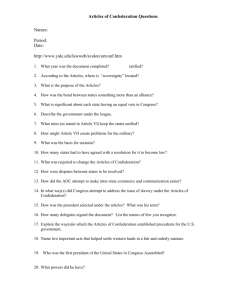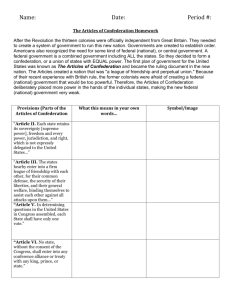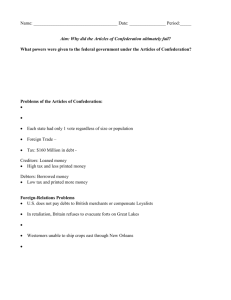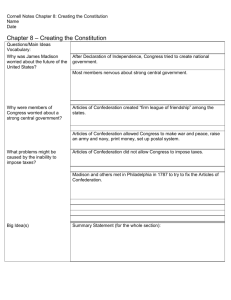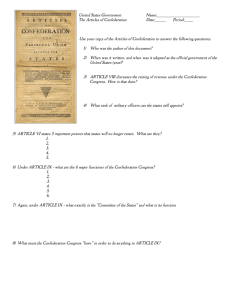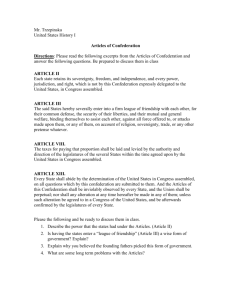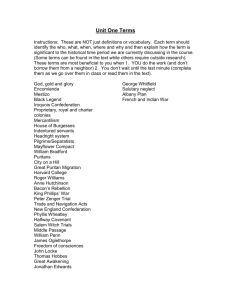Articles of Confederation
advertisement
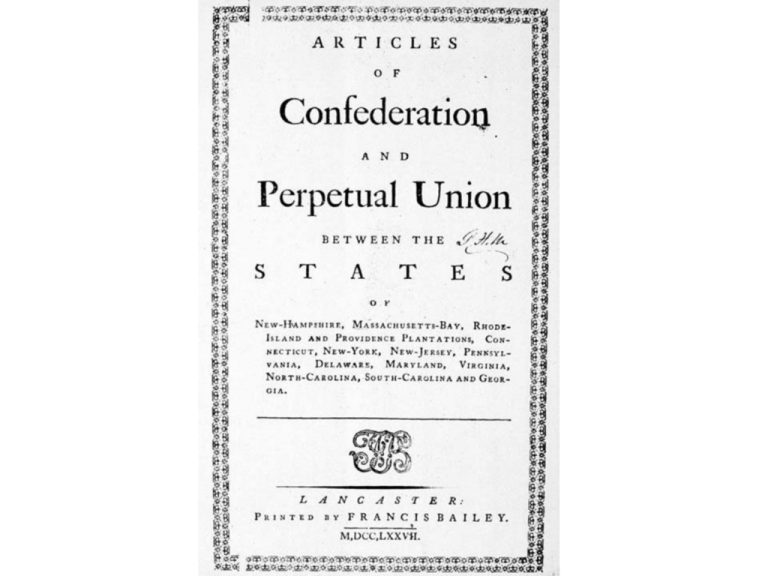
The Articles of Confederation Agreed to by Congress November 15, 1777; ratified and in force, March 1, 1781. Preamble To all to whom these Presents shall come, we the undersigned Delegates of the States affixed to our Names send greeting. Articles of Confederation and perpetual Union between the States of New Hampshire, Massachusetts bay, Rhode Island and Providence Plantations, Connecticut, New York, New Jersey, Pennsylvania, Delaware, Maryland, Virginia, North Carolina, South Carolina and Georgia. Article I. The Stile of this Confederacy shall be "The United States of America.“ Article II. Each state retains its sovereignty, freedom, and independence, and every power, jurisdiction, and right, which is not by this Confederation expressly delegated to the United States, in Congress assembled. Article III. The said States hereby severally enter into a firm league of friendship with each other, for their common defense, the security of their liberties, and their mutual and general welfare, binding themselves to assist each other, against all force offered to, or attacks made upon them, or any of them, on account of religion, sovereignty, trade, or any other pretense whatever. III. What was our first Constitution? A. The Articles of Confederation 1781-1789 B. How was the national government organized under the Articles of Confederation? 1. One branch a. One-House legislature—The Confederation Congress b. No executive branch – no president c. No national court system – each state had their own court system 2. Each state—One vote in the Confederation Congress 3. National government had no power to tax 4. 9 states out of 13 had to approve any law 5. 13 states had to approve a change to the Articles of Confederation President of the Congress Assembled 1. John Hanson (1782) 2. Elias Boudinot (1783) 3. Thomas Mifflin (1784) 4. Richard Henry Lee (1785) 5. John Hancock (1786) 6. Nathan Gorman (1787) 7. Arthur St. Clair (1788) 8. Cyrus Griffin (1789) C. Achievements 1. The Treaty of Paris 1783 2. The Northwest Ordinance Allowed for territories in Northwest region to organize and become states. Abolished slavery in new states E. Life under the Articles of Confederation 1. Each state had its own currency and the National Government had its own currency. In other words there were 14 different types of money printed and merchants would not accept money from another state. 2. The only way the National Government could raise money was by asking the states for it. South Carolina never paid the National Government. The National Government could not pay back France or The Netherlands the money borrowed to fight the war. No foreign country would lend us money. 3. Citizens of states would order goods from foreign countries and then refuse to pay for them. Soon all foreign trade stopped. 4. Because of its harbor, most shipping went to New York. New York started charging a tax to let goods leave the state. 5. Connecticut closed its border and would not allow farmers in Massachusetts or New York sell their goods in Connecticut. 6. New York and New Hampshire both claimed the territory of Vermont and went to war over it. The people in Vermont wanted no part of either state and fought against both. 7. Connecticut claimed land in Pennsylvania and tried to establish a colony in the city now known as Wilkes Barre. A war was started know as the Pennamite War. 8. Pirates raided our merchant shipping and the National Government had no money to build a navy. 9. Citizens would order goods from another state and then refuse to pay for them. There was no national court system to make a claim to enforce the sale. 10. The National Government could not pay the soldiers who fought in the Revolutionary War. The farmers started losing their farms and revolted in every state by burning courthouses. Shays’ Rebellion was the largest rebellion. 11. Delaware refused to let New Jersey use the Delaware River. Maryland refused to let Virginia use the Potomac River. D. Problems with the Articles of Confederation 1. The National Government did not have money and had no power to raise money. 2. The National Government had no power over the states or their citizens. 3. The National Government could not make the states live up to trade agreements with other nations 4. The National Government had no power over trade between states 5. The National Government could not protect its citizens.

